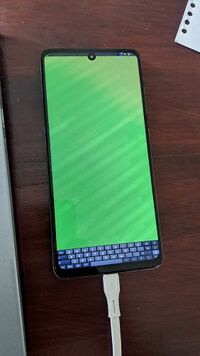Samsung Galaxy A51 (samsung-a51)
| This device runs a Downstream kernel. Some UIs will not work, and most features (3D acceleration, audio, etc.) may be broken. |
 Samsung Galaxy A51, running postmarketOS with XFCE 4 | |
| Manufacturer | Samsung |
|---|---|
| Name | Galaxy A51 |
| Codename | samsung-a51 |
| Model | SM-A515 |
| Released | 2019 |
| Type | handset |
| Hardware | |
| Chipset | Samsung Exynos 9611 |
| CPU |
4x 2.3 GHz Cortex-A73 4x 1.7 GHz Cortex-A53 |
| GPU | Mali-G72 |
| Display | 1080 x 2400 Super AMOLED |
| Storage | 64GB / 128GB / 256GB |
| Memory | 4GB / 8GB |
| Architecture | aarch64 |
| Software | |
Original software The software and version the device was shipped with. |
Android 13 |
Extended version The most recent supported version from the manufacturer. |
Android |
| postmarketOS | |
| Category | downstream |
Mainline Instead of a Linux kernel fork, it is possible to run (Close to) Mainline. |
no |
pmOS kernel The kernel version that runs on the device's port. |
4.14.113 |
Unixbench score Unixbench Whetstone/Dhrystone score. See Unixbench. |
3413.6 |
| Device package |
|
| Kernel package |
|
Flashing Whether it is possible to flash the device with pmbootstrap flasher. |
Partial
|
|---|---|
USB Networking After connecting the device with USB to your PC, you can connect to it via telnet (initramfs) or SSH (booted system). |
Works
|
Internal storage eMMC, SD cards, UFS... |
Works
|
SD card Also includes other external storage cards. |
Untested
|
Battery Whether charging and battery level reporting work. |
Works
|
Screen Whether the display works; ideally with sleep mode and brightness control. |
Works
|
Touchscreen |
Works
|
| Multimedia | |
3D Acceleration |
Untested
|
Audio Audio playback, microphone, headset and buttons. |
Untested
|
Camera |
Untested
|
Camera Flash |
Untested
|
| Connectivity | |
WiFi |
Works
|
Bluetooth |
Untested
|
Ethernet |
Untested
|
GPS |
Untested
|
NFC Near Field Communication |
Untested
|
| Modem | |
Calls |
Untested
|
SMS |
Untested
|
Mobile data |
Untested
|
| Miscellaneous | |
FDE Full disk encryption and unlocking with unl0kr. |
Untested
|
USB OTG USB On-The-Go or USB-C Role switching. |
Untested
|
HDMI/DP Video and audio output with HDMI or DisplayPort. |
Untested
|
| Sensors | |
Accelerometer Handles automatic screen rotation in many interfaces. |
Untested
|
Magnetometer Sensor to measure the Earth's magnetism |
Untested
|
Ambient Light Measures the light level; used for automatic screen dimming in many interfaces. |
Untested
|
Proximity |
Untested
|
Haptics |
Untested
|
Contributors
- manoedinata
Users owning this device
- Leahh
- Manoedinata (Notes: 8/128, screen replaced. Broken power button, so I can't boot it easily.)
- MettleSphee
- SeMi2309
- Xyno (Notes: Working on creating the best experience on SXMO)
How to enter recovery/Odin mode
- Press and hold + simultaneously while device is powered off, then plug USB cable in for Odin mode.
- Press and hold + simultaneously while device is powered off, then plug in USB cable for recovery mode.
- Press and hold + simultaneously for 7-8 seconds while device is powered on to force reboot. Once time is up immediately release the keys and press one of combinations above before boot logo appears, otherwise device will boot normally.
Installation
Use pmbootstrap to build your own installation image. The device configuration will also build firmware package, which contains required proprietary blobs for Wi-Fi.
Since dynamic partition support hasn't been added to the port, you will have to either install to external SD Card or use userdata partition as postmarketOS' root partition. This can be done by adding --recovery-install-partition=data to your pmbootstrap's install command. See Installation from recovery mode for more information.
Heimdall installation is untested. Use Installation_from_recovery_mode instead.
| Particularly for this device, ADB Sideloading through TWRP may cause the installation process to hang after finishing the installation. Install postmarketOS with TWRP's GUI instead. |
Known Working
- Touchscreen
- Display (with Samsung's DECON driver)
- Framebuffer (additionally with msm-fb-refresher to refresh the screen)
- Charging & battery status
- Volume (tested on XFCE)
- Screen brightness changing (partially)
- Wi-Fi (with firmware package)
Notes
USB Networking
The device isn't detected on the computer while plugged in through USB cable.
dmesg on host shows nothing related to new device being connected. While similar device like Samsung Galaxy Note 9 (Exynos) (samsung-crownlte) and Samsung Galaxy S8 (samsung-dreamlte) uses additional initramfs hook, that doesn't help at all - nothing in dmesg on PC.
USB Networking works without any additional setup by enabling CONFIG_USB_ETH (and additionally CONFIG_USB_ETH_RNDIS).
Wi-Fi
Although the required proprietary blobs are loaded and Wi-Fi did turn on, it can't connect to any available network. This assumption is based on attempt to connect to an AP through NetworkManager (on XFCE 4). Needs more investigation.
To enable Wi-Fi, these proprietary blobs are required to be loaded:
vendor/etc/wifi/mx vendor/etc/wifi/mx140.bin vendor/etc/wifi/mx140_wlan.hcf vendor/etc/wifi/mx140_wlan_sw.hcf
These files are pulled and packaged already in firmware-samsung-a51 pmaports package.
Framebuffer
Some patches are required for framebuffer to fix some issues, e.g. swapped color, missing fb0 device, etc. The last one is required to boot framebuffer-based or text interfaces with CONFIG_FRAMEBUFFER_CONSOLE, or if you want to display kernel console to the screen, otherwise the kernel panics with null pointer dereference.
See also
- pmaports!5887 Initial merge request